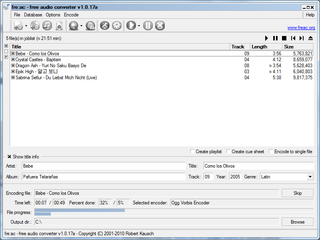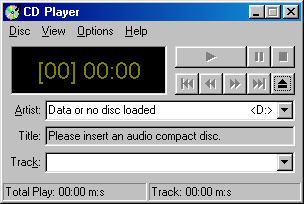
The compact disc (CD) is a digital optical disc data storage format that was co-developed by Philips and Sony to store and play digital audio recordings. The first compact disc was manufactured in August 1982, and was first released in Japan in October 1982 as Compact Disc Digital Audio. The CD was more compact than the LaserDisc (LD) developed in the 1970s. The CD gained rapid popularity in the 1990s. It quickly outsold all other audio formats in the United States by 1991, ending the market dominance of the phonograph record and the cassette tape. By 2000, the CD accounted for 92.3% of the entire market share in regard to music sales. The CD is considered the last dominant audio format of the album era, as the rise of MP3, iTunes, cellular ringtones, and other downloadable music formats in the mid-2000s ended the decade-long dominance of the CD.

Compact Disc Digital Audio, also known as Digital Audio Compact Disc or simply as Audio CD, is the standard format for audio compact discs. The standard is defined in the Red Book, one of a series of Rainbow Books that contain the technical specifications for all CD formats.

Video CD is a home video format and the first format for distributing films on standard 120 mm (4.7 in) optical discs. The format was widely adopted in Southeast Asia, South Asia, Greater China, Central Asia and West Asia, superseding the VHS and Betamax systems in the regions until DVD-Video finally became affordable in the first decade of the 21st century.

A CD ripper, CD grabber, or CD extractor is software that rips raw digital audio in Compact Disc Digital Audio (CD-DA) format tracks on a compact disc to standard computer sound files, such as WAV or MP3.
A DVD player is a device that plays DVDs produced under both the DVD-Video and DVD-Audio technical standards, two different and incompatible standards. Some DVD players will also play audio CDs. DVD players are connected to a television to watch the DVD content, which could be a movie, a recorded TV show, or other content.
An optical disc image is a disk image that contains everything that would be written to an optical disc, disk sector by disc sector, including the optical disc file system. ISO images contain the binary image of an optical media file system, including the data in its files in binary format, copied exactly as they were stored on the disc. The data inside the ISO image will be structured according to the file system that was used on the optical disc from which it was created.
Ripping is the extraction of digital content from a container, such as a CD, onto a new digital location. Originally, the term meant to rip music from Commodore 64 games. Later, the term was applied to ripping WAV or MP3 files from digital audio CDs, and after that to the extraction of contents from any storage media, including DVD and Blu-ray discs, as well as the extraction of video game sprites.
SafeDisc is a copy protection program for Microsoft Windows applications and games distributed on optical disc. Created by Macrovision Corporation, it was aimed to hinder unauthorized disc duplication. The program was first introduced in 1998 and was discontinued on March 31, 2009.

MediaMax CD-3 is a software package created by SunnComm which was sold as a form of copy protection for compact discs. It was used by the record label RCA Records/BMG, and targets both Microsoft Windows and Mac OS X. Elected officials and computer security experts regard the software as a form of malware since its purpose is to intercept and inhibit normal computer operation without the user's authorization. MediaMax received media attention in late 2005 in fallout from the Sony XCP copy protection scandal.
CD/DVD copy protection is a blanket term for various methods of copy protection for CDs and DVDs. Such methods include DRM, CD-checks, Dummy Files, illegal tables of contents, over-sizing or over-burning the CD, physical errors and bad sectors. Many protection schemes rely on breaking compliance with CD and DVD standards, leading to playback problems on some devices.
A cue sheet, or cue file, is a metadata file which describes how the tracks of a CD or DVD are laid out. Cue sheets are stored as plain text files and commonly have a .cue filename extension. CDRWIN first introduced cue sheets, which are now supported by many optical disc authoring applications and media players.
key2audio is a copy restriction system for Audio CDs, developed by Sony DADC. The system gained notoriety after it was discovered that one can effectively disable the system by tracing the outer edge of a CD with a felt-tip marker.

Extended Copy Protection (XCP) is a software package developed by the British company First 4 Internet and sold as a copy protection or digital rights management (DRM) scheme for Compact Discs. It was used on some CDs distributed by Sony BMG and sparked the 2005 Sony BMG CD copy protection scandal; in that context it is also known as the Sony rootkit.
Cactus Data Shield (CDS) is a form of CD/DVD copy protection for audio compact discs developed by Israeli company Midbar Technologies. It has been used extensively by EMI, BMG and their subsidiaries. CDS relies on two components: Erroneous Disc Navigation and Data Corruption.

The Blue Book is a compact disc standard developed in 1995 by Philips and Sony. It defines the Enhanced Music CD format, which combines audio tracks and data tracks on the same disc. The format was created as a way to solve the problem of mixed mode CDs, which were not properly supported by many CD players.
Subcode or subchannel data refers to data contained in a compact disc (CD) in addition to digital audio or user data, which is used for control and playback of the CD. The original specification was defined in the Red Book standard for CD Digital Audio, though further specifications have extended their use.

A CD-ROM is a type of read-only memory consisting of a pre-pressed optical compact disc that contains data. Computers can read—but not write or erase—CD-ROMs. Some CDs, called enhanced CDs, hold both computer data and audio with the latter capable of being played on a CD player, while data is only usable on a computer.

CD Player is a computer program that plays audio CDs using the computer's sound card. It was included in Windows 95, Windows 98, Windows NT 3.51, Windows NT 4.0 and Windows 2000. It was removed from Windows ME and beyond in favor of "CD/DVD playback functionality" in Windows Media Player.
A digital copy is a commercially distributed computer file containing a media product such as a film or music album. The term contrasts this computer file with the physical copy with which the digital copy is usually offered as part of a bundle. It allows the disc's purchaser to acquire a single copy of the film on a digital device such as a personal computer, smartphone, tablet computer, or digital media player, and view it on those devices without requiring access to the physical media. "Digital copy" is also commonly referred to as "Digital HD".









